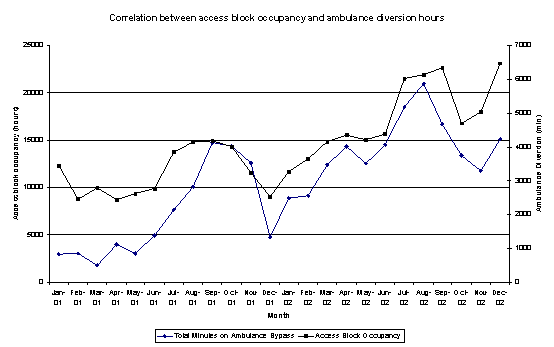Nosokinetics
EMERGENCY DEPARTMENT OVERCROWDING
(c) DM Fatovich MBBS FACEM
Access Blocks and Ambulance Diversions etc in Perth, Western Australis
'Access block' refers to the situation where patients in the Emergency Department (ED) requiring inpatient care are unable to gain access to appropriate hospital beds within a reasonable time frame. We systematically evaluated the relationship between access block, emergency department overcrowding, ambulance diversion and emergency department activity.
We found that Emergency Department overcrowding (r=0.96; 95%CI 0.91-0.98), ambulance diversion (r=0.75; 95%CI 0.49-0.88; see Fig) and ED waiting times for care (r=0.83; 95%CI 0.65-0.93) were strongly correlated with high levels of ED occupancy by access blocked patients. Total attendances, admissions, discharges and low acuity patient attendances were not associated with ambulance diversion.

Fig 1 - Relationship between access blocked ED occupancy and ambulance diversion.
This figure illustrates the correlation between the rise in access block ED occupancy and the total number of ambulance diversion hours between 2001 and 2002. Between 2001 and 2002, the proportion of access blocked patients increased from 11% to 16% (45% increase, p<0.001).
Reducing access block should be the highest priority in allocating resources to reduce ED overcrowding. This would result in reduced overcrowding, reduced ambulance diversion and improve ED waiting times. Improving hospital inpatient flow, which would directly reduce access block, is most likely to achieve this. Conversely, decreasing low acuity patient attendances will have minimal impact on decreasing ambulance diversion and ED overcrowding.
Reference:
DM Fatovich, Y Nagree and P Sprivulis (2005). Access block causes emergency department overcrowding and ambulance diversion in Perth, Western Australia. Emerg. Med. J. 22:351-354.
Some navigational notes:
A highlighted number may bring up a footnote or a reference. A highlighted word hotlinks to another document (chapter, appendix, table of contents, whatever). In general, if you click on the 'Back' button it will bring to to the point of departure in the document from which you came.Copyright (c)Roy Johnston, Peter Millard, 2005, for e-version; content is author's copyright,